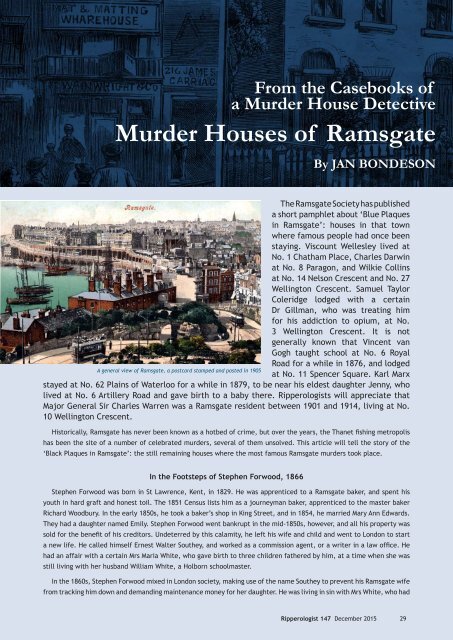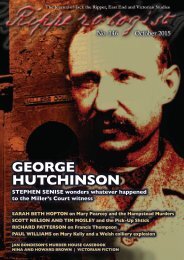Edmund Reid
nuhf574
nuhf574
Create successful ePaper yourself
Turn your PDF publications into a flip-book with our unique Google optimized e-Paper software.
From the Casebooks of<br />
a Murder House Detective<br />
Murder Houses of Ramsgate<br />
By JAN BONDESON<br />
The Ramsgate Society has published<br />
a short pamphlet about ‘Blue Plaques<br />
in Ramsgate’: houses in that town<br />
where famous people had once been<br />
staying. Viscount Wellesley lived at<br />
No. 1 Chatham Place, Charles Darwin<br />
at No. 8 Paragon, and Wilkie Collins<br />
at No. 14 Nelson Crescent and No. 27<br />
Wellington Crescent. Samuel Taylor<br />
Coleridge lodged with a certain<br />
Dr Gillman, who was treating him<br />
for his addiction to opium, at No.<br />
3 Wellington Crescent. It is not<br />
generally known that Vincent van<br />
Gogh taught school at No. 6 Royal<br />
Road for a while in 1876, and lodged<br />
A general view of Ramsgate, a postcard stamped and posted in 1905<br />
at No. 11 Spencer Square. Karl Marx<br />
stayed at No. 62 Plains of Waterloo for a while in 1879, to be near his eldest daughter Jenny, who<br />
lived at No. 6 Artillery Road and gave birth to a baby there. Ripperologists will appreciate that<br />
Major General Sir Charles Warren was a Ramsgate resident between 1901 and 1914, living at No.<br />
10 Wellington Crescent.<br />
Historically, Ramsgate has never been known as a hotbed of crime, but over the years, the Thanet fishing metropolis<br />
has been the site of a number of celebrated murders, several of them unsolved. This article will tell the story of the<br />
‘Black Plaques in Ramsgate’: the still remaining houses where the most famous Ramsgate murders took place.<br />
In the Footsteps of Stephen Forwood, 1866<br />
Stephen Forwood was born in St Lawrence, Kent, in 1829. He was apprenticed to a Ramsgate baker, and spent his<br />
youth in hard graft and honest toil. The 1851 Census lists him as a journeyman baker, apprenticed to the master baker<br />
Richard Woodbury. In the early 1850s, he took a baker’s shop in King Street, and in 1854, he married Mary Ann Edwards.<br />
They had a daughter named Emily. Stephen Forwood went bankrupt in the mid-1850s, however, and all his property was<br />
sold for the benefit of his creditors. Undeterred by this calamity, he left his wife and child and went to London to start<br />
a new life. He called himself Ernest Walter Southey, and worked as a commission agent, or a writer in a law office. He<br />
had an affair with a certain Mrs Maria White, who gave birth to three children fathered by him, at a time when she was<br />
still living with her husband William White, a Holborn schoolmaster.<br />
In the 1860s, Stephen Forwood mixed in London society, making use of the name Southey to prevent his Ramsgate wife<br />
from tracking him down and demanding maintenance money for her daughter. He was living in sin with Mrs White, who had<br />
Ripperologist 147 December 2015 29




